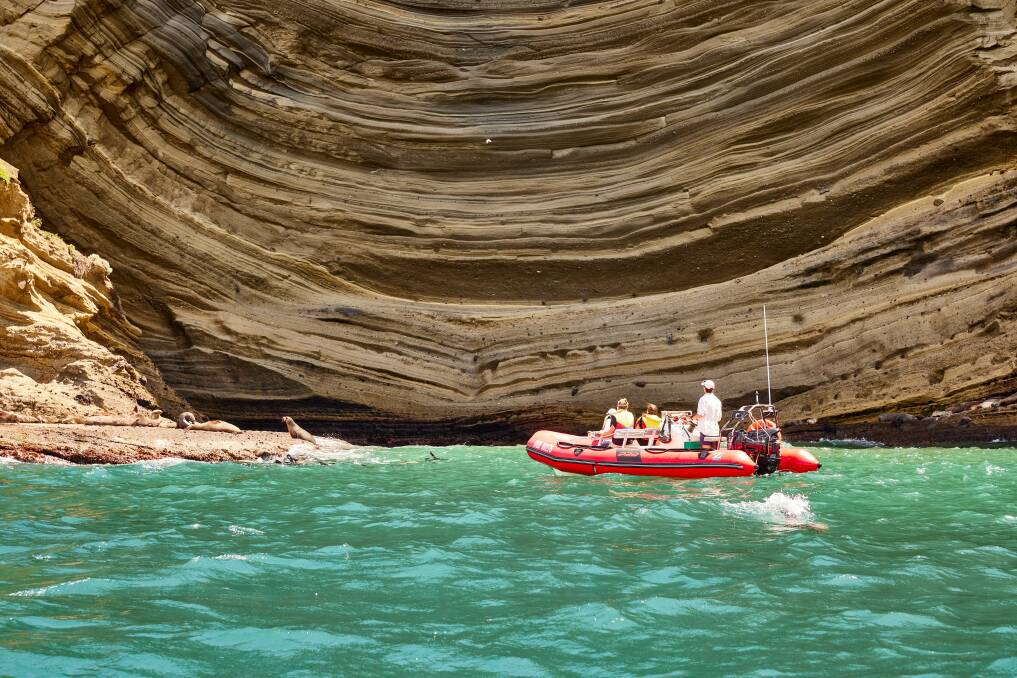Think the Great Ocean Road stops at Warrnambool? Think again.
Create a free account to read this article
$0/
(min cost $0)
or signup to continue reading
On the coast outside of Portland, the bellows and barks of fur seals rise up the walls of Victoria's highest sea cliffs. Rain cells march across the Southern Ocean, and wind turbines turn cartwheels on the breezes that have pruned much of the scrub on Cape Bridgewater almost to bonsai.

There are twin seal colonies below me, a petrified forest of sorts behind and an Enchanted Forest away on the next cape. The Great Ocean Road might end at Warrnambool, little more than an hour's drive to the east, but stand here and the reality doesn't seem so clear-cut. Portland gets overlooked by most Great Ocean Road tourers, but its capes and coastline are every bit as great as anything along that celebrated road.
Settled in 1834, Portland is Victoria's oldest town and the only deep-water port between Melbourne and Adelaide, but it's what lies beyond the town limits that's most enticing. Shaped by some of Australia's most recent volcanic activity, Portland bursts into beauty around the two capes, Cape Nelson and Cape Bridgewater, to its immediate west.
The best way to experience these capes is on foot, with one of Australia's oldest, and still least known, long-distance bushwalks - the 250-kilometre Great South West Walk - wrapping around their edges. Proximity to Portland means you can use the trail to explore the capes on day walks less than 30 minutes' drive from town.

Lighthouse-topped Cape Nelson, which was one of the settings for the 2011 Miranda Otto movie South Solitary, all but rolls out from the back of town. As we set out walking towards the cape from beside Portland's enormous aluminium smelter, threading between the wind turbines that tower out of the scrub, I feel like Don Quixote charging at La Mancha's windmills.
Behind the smelter, on Point Danger, Australasian gannets ride the winds, hovering over Australia's only mainland rookery for these sleek seabirds. More than 600 gannet pairs nest here - a crowd of birds so dense that the point appears white from afar.
Read more on Explore:
From the smelter, it's a quick walk through the scrub to the edge of the limestone cliffs that hang above the sea. It's the same rock and the same beauty, in constant erosion from the Southern Ocean, as the coast around the 12 Apostles. All that's missing are the sea stacks.
There's also no rainforest here to match the Great Ocean Road's Otway Range, but as the coast and the walk turn onto the flanks of Cape Nelson, there is the Enchanted Forest. In a landscape of low scrub, this tall stand of black tea-tree is perhaps the most unexpected sight of all, rising high over the trail in dark, skeletal limbs. Throw in a sea mist and it could be the setting for a spooky novel.
Just 10 kilometres to the west, across Bridgewater Bay, Cape Bridgewater is a grander version of Cape Nelson. Part of the rim of a volcanic crater, the cape is framed in 135-metre-high cliffs - higher than any cliff along the Great Ocean Road.

On the cape's eastern side, the roads end beside a blowhole and a fury of ocean, and it's from here that we set out again on foot the next day, heading south along the cliff edge into the Petrified Forest.
This otherworldly geological feature was once thought to be an ancient forest consumed by sand (hence the name) but later came to be understood as a curious collection of hollow limestone tubes, rising from the earth like the columns of a ruined Greek settlement. It's the forest that never was.
Along the cliff edge, the bush thins to sparse patches of saltbush, and it's like walking through a coastal desert. Stunted by wind, little here grows above knee height, opening out wide views over the ocean and coast.
Seals lounge about on the rock platform at the base of the cliffs, while the sea is speckled with other pups taking their first swimming lessons.
Behind us, Mt Richmond crouches low on the coastal plain. Protected as a national park, the mountain makes for a worthwhile detour, providing a range of walking trails among the likes of koalas and echidnas and an elevated outlook over the dune-backed coastline.
Round the southern tip of Cape Bridgewater and things get immediately lively. As the walking track rises up a grassy slope, a string of lookout platforms peer down onto two distinct seal colonies, one for Australian fur seals and the other for New Zealand fur seals.
It's Australia's only mainland breeding site for both species, with up to 2000 seals coming to give birth each year. Seals lounge about on the rock platform at the base of the cliffs, while the sea is speckled with other pups taking their first swimming lessons.

Past the lookouts, the track climbs on, ascending another grassy slope to finally crest the highest sea cliff in Victoria. Bridgewater Bay yawns open below, cliffs plummet into the sea, and Cape Nelson stands staked into the sea by its lighthouse. There are seals below, whales in season and forests both enchanted and imagined. It's great in every way except the name.
TRIP NOTES
Getting there: Portland is 350 kilometres west of Melbourne. The nearest airport is Mount Gambier, 100 kilometres to the west. Rex (rex.com.au) flies to Mount Gambier from Melbourne and Adelaide.
Staying there: History-rich Victoria House is set inside a heritage-listed 1853 Georgian hotel, just a few steps from Portland's foreshore. Rooms from $153 a night. Phone 03 5521 7577
Walking there: Hedonistic Hiking runs a seven-day South West Coast and The Grampians trip, starting from $3795, that includes walks around Cape Bridgewater and Cape Nelson. See hedonistichiking.com
Explore more: visitportland.com.au
The writer was a guest of Hedonistic Hiking.




